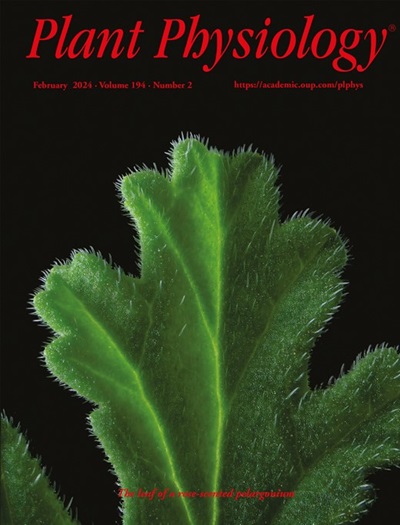Nhd1-MYB110-MADS15转录因子模块调控水稻开花时间
IF 6.5
1区 生物学
Q1 PLANT SCIENCES
引用次数: 0
摘要
水稻(Oryza sativa L.)开花时间(即抽穗日期)的精确调控对区域适应、农业生产力和作物轮作做法至关重要。在水稻中,成花激活复合物(FAC)及其下游效应物是茎尖分生组织(SAM)成花转变的重要媒介。在这里,我们将OsMYB110描述为sam定位的转录因子,可以促进开花,其功能与已建立的开花调节因子Nhd1 (n介导的抽穗日期-1)相似。通过综合分子和遗传学分析,我们发现:(1)Nhd1直接结合OsMYB110启动子激活其表达,而OsMYB110反过来结合并激活OsMADS15启动子控制开花进程;(2)在开花调控层次中,OsMYB110位于Nhd1的下游,而OsMADS15的上游。此外,虽然升高的磷酸盐加速开花,但这种反应在myb110和mads15突变体中被消除,而在nhd1突变体中保持。这些结果确定了一个以前未被认识的Nhd1-OsMYB110-OsMADS15调控模块,该模块整合了发育和营养信号通路来控制水稻开花时间。本文章由计算机程序翻译,如有差异,请以英文原文为准。
The Nhd1–MYB110–MADS15 transcription factor module regulates flowering time in rice
The precise regulation of flowering time, known as heading date in rice (Oryza sativa L.), is critical for regional adaptation, agricultural productivity, and crop rotation practices. In rice, the florigen activation complex (FAC) and its downstream effectors are well-characterized mediators of the floral transition in the shoot apical meristem (SAM). Here, we characterized OsMYB110 as a SAM-localized transcription factor that promotes flowering, exhibiting functional similarity to the established flowering regulator Nhd1 (N-mediated heading date-1). Through integrated molecular and genetic analyses, we demonstrate that: (1) Nhd1 directly binds to the OsMYB110 promoter to activate its expression, while OsMYB110 in turn binds to and activates the OsMADS15 promoter to control flowering progression, and (2) genetic epistasis places OsMYB110 downstream of Nhd1 but upstream of OsMADS15 in the flowering regulation hierarchy. Furthermore, while elevated phosphate accelerates flowering, this response is abolished in myb110 and mads15 mutants but maintained in nhd1 mutants. These results define a previously unrecognized Nhd1–OsMYB110–OsMADS15 regulatory module that integrates developmental and nutrient signaling pathways to control rice flowering time.
求助全文
通过发布文献求助,成功后即可免费获取论文全文。
去求助
来源期刊

Plant Physiology
生物-植物科学
CiteScore
12.20
自引率
5.40%
发文量
535
审稿时长
2.3 months
期刊介绍:
Plant Physiology® is a distinguished and highly respected journal with a rich history dating back to its establishment in 1926. It stands as a leading international publication in the field of plant biology, covering a comprehensive range of topics from the molecular and structural aspects of plant life to systems biology and ecophysiology. Recognized as the most highly cited journal in plant sciences, Plant Physiology® is a testament to its commitment to excellence and the dissemination of groundbreaking research.
As the official publication of the American Society of Plant Biologists, Plant Physiology® upholds rigorous peer-review standards, ensuring that the scientific community receives the highest quality research. The journal releases 12 issues annually, providing a steady stream of new findings and insights to its readership.
 求助内容:
求助内容: 应助结果提醒方式:
应助结果提醒方式:


